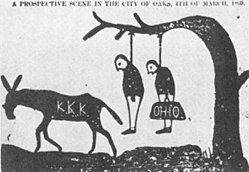
[I tried to post this as a photo & comments to Facebook last Friday. It didn't work out quite right. I'm going to re-post this as a blog post. Sorry if you've read it before.]
I'm in the state capitol today at a student conference, and I want to share some observations about my state.
This statue in the Capitol gallery is of Nathan Bedford Forrest, a man who fought AGAINST the United States. Moreover, he was a founder of the Klu Klux Klan.
So why does his statute occupy a priviledged place in the Capitol? It is an example of the South's complicated relationship with America's history, with the country's present, and with the future.
Forrest was one of the Confederacy's most effective raiders. Never defeated in battle, his motto was "get there first with the most." At war's end, he became a potent Southern leader at a time when Northern opportunists were raiding the Southern economy for quick profit and political gain (like Lincoln,these transplanted "carpetbaggers" were Republicans, which is why, from the end of Reconstruction in 1876 to the 1990s, Republicans were considered with abhorrence by conservative Southern whites.
 Forrest's days as the first "Grand Wizard " of the KKK were short but effective. In modern parlance, he claimed that the KKK was a "fair and balanced" alternative to the Republican "Loyal Leagues." As one Alabama newspaper put it, "The League is nothing more than a nigger Ku Klux Klan." One editorial cartoon of the period showed a KKK lynching: its victims were white, and written on one victim's carpet bag was the word, "Ohio."
Forrest's days as the first "Grand Wizard " of the KKK were short but effective. In modern parlance, he claimed that the KKK was a "fair and balanced" alternative to the Republican "Loyal Leagues." As one Alabama newspaper put it, "The League is nothing more than a nigger Ku Klux Klan." One editorial cartoon of the period showed a KKK lynching: its victims were white, and written on one victim's carpet bag was the word, "Ohio."Today we think of Forrest's KKK in strictly racial terms. In the 20th century, their burning crosses and white-capped members sought to intimidate Southern blacks into compliance with segregation.
But I know of no attacks that Forrest carried out against freed slaves. His target was Republicans. He hounded them out of their judgeships, targeted Northern-owned industries, and eventually returned the South to the dominance of the political, Democratic, conservative class that had ruled from the time of Andrew Jackson to the end of the Civil War. Forrest was a SOUTHERN patriot, even if he wasn't an AMERICAN one.
Eventually things got out of control. The armed "night riders" under the sheets weren't always acting for political reasons. Shortly after a federal grand jury declared the Klan a "terrorist organization"in 1870, Forrest disbanded the organization completely, claiming that it had been "perverted from its original honorable and patriotic purposes, becoming injurious instead of subservient to the public peace."
The closing years of Forrest's life wouldn't seem to reflect the actions of a notorious racist. The New York Times, in its obituary of Forrest, October 30, 1877, noted that his last public appearance was before a 4th-of-July celebration of African-Americans near Forrest's home in Memphis:
"[In] his last notable public appearance .... he appeared before the colored people at their celebration, was publicly presented with a bouquet by them as a mark of peace and reconciliation, and made a friendly speech in reply. In this he once more took occasion to defend himself and his war record, and to declare that he was a hearty friend of the colored race. "This brings to light two ironies of Tennessee's Capitol today.
One: both legislative chambers in Tennessee's Capitol are controlled by Republicans! If Forrest were to return from the grave and learn this, there would be hell to pay. Folks would get hanged. The Capitol might even be burned.
The second irony can be found on the wall that Forrest's statue looks at. It's time for lunch, but I'll develop this more a little later.
No comments:
Post a Comment